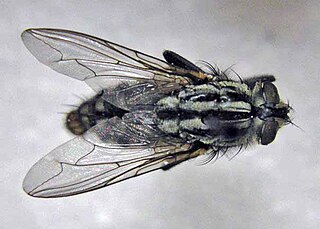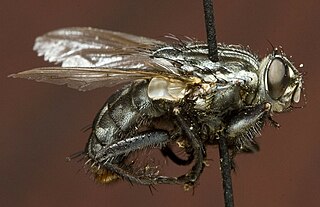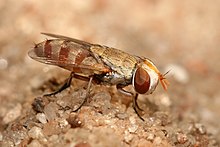
Flies are insects of the order Diptera, the name being derived from the Greek δι- di- "two", and πτερόν pteron "wing". Insects of this order use only a single pair of wings to fly, the hindwings having evolved into advanced mechanosensory organs known as halteres, which act as high-speed sensors of rotational movement and allow dipterans to perform advanced aerobatics. Diptera is a large order containing an estimated 1,000,000 species including horse-flies, crane flies, hoverflies and others, although only about 125,000 species have been described.

The Bombyliidae are a family of flies. Their common name are bee flies or humbleflies. Adults generally feed on nectar and pollen, some being important pollinators. Larvae generally are parasitoids of other insects.

The Calliphoridae are a family of insects in the order Diptera, with 1,200 known species. The maggot larvae, often used as fishing bait, are known as gentles. The family is known to be polyphyletic, but much remains disputed regarding proper treatment of the constituent taxa, some of which are occasionally accorded family status.

Sarcophagidae are a family of flies commonly known as flesh flies. They differ from most flies in that they are ovoviviparous, opportunistically depositing hatched or hatching maggots instead of eggs on carrion, dung, decaying material, or open wounds of mammals, hence their common name. Some flesh fly larvae are internal parasites of other insects such as Orthoptera, and some, in particular the Miltogramminae, are kleptoparasites of solitary Hymenoptera. The adults mostly feed on fluids from animal bodies, nectar, sweet foods, fluids from animal waste and other organic substances. Juveniles need protein to develop and may be laid on carrion, dung or sweet plant foods.

The Tephritidae are one of two fly families referred to as fruit flies, the other family being the Drosophilidae. The family Tephritidae does not include the biological model organisms of the genus Drosophila, which is often called the "common fruit fly". Nearly 5,000 described species of tephritid fruit fly are categorized in almost 500 genera of the Tephritidae. Description, recategorization, and genetic analyses are constantly changing the taxonomy of this family. To distinguish them from the Drosophilidae, the Tephritidae are sometimes called peacock flies, in reference to their elaborate and colorful markings. The name comes from the Greek τεφρος, tephros, meaning "ash grey". They are found in all the biogeographic realms.

The Micropezidae are a moderate-sized family of acalyptrate muscoid flies in the insect order Diptera, comprising about 500 species in about 50 genera and five subfamilies worldwide,. They are most diverse in tropical and subtropical habitats, especially in the Neotropical Region.

Opomyzidae is a family of acalyptrate Diptera. They are generally small, slender, yellow, brown or black coloured flies. The larval food plants are grasses, including cereal crops, the adults are mainly found in open habitats. Some species being agricultural pests.

Sarcophaga is a genus of true flies and the type genus of the flesh-fly family (Sarcophagidae). The members of this cosmopolitan genus are frequently known as common flesh flies.

The Miltogramminae are a subfamily of the family Sarcophagidae. They are kleptoparasites of solitary bees and solitary wasps.

Sarcophaga pernix, also known as the red-tailed flesh fly, is a fly in the Sarcophagidae family. This fly often breeds in carrion and feces, making it a possible vector for disease. The larvae of this species can cause myiasis, as well as accidental myiasis. It is potentially useful in forensic entomology.

Sarcophaga bullata, or the grey flesh fly, is a species of fly belonging to the family Sarcophagidae. It varies in size from small to large, 8 to 17 millimeters in length and is very similar in appearance and behavior to a closely related species, Sarcophaga haemorrhoidalis. S. bullata is a common scavenger species in the Eastern United States, but is found throughout the Nearctic region. Identification down to the species level in the family Sarcophagidae is notably difficult and relies primarily on the male genitalia. Though limited information is available regarding S. bullata, it has gained increasing recognition in the field of forensic entomology as a forensically-relevant fly species, as it may be among the first species to colonize human remains. In these instances, recovered maggots may be analyzed for post-mortem interval (PMI) estimations, which may be used as evidence in courts of law. Current studies regarding S. bullata have revealed a maternal effect operating in these flies that prevents pupal diapause under certain environmental conditions, which is an important factor to be considered during forensic analyses.
Ocnerioxyna is a genus of tephritid or fruit flies in the family Tephritidae.
Oedaspis is a genus of tephritid or fruit flies in the family Tephritidae.
Pliomelaena is a genus of tephritid or fruit flies in the family Tephritidae.
Rhochmopterum is a genus of tephritid or fruit flies in the family Tephritidae.
Diptera is an order of winged insects commonly known as flies. Diptera, which are one of the most successful groups of organisms on Earth, are very diverse biologically. None are truly marine but they occupy virtually every terrestrial niche. Many have co-evolved in association with plants and animals. The Diptera are a very significant group in the decomposition and degeneration of plant and animal matter, are instrumental in the breakdown and release of nutrients back into the soil, and whose larvae supplement the diet of higher agrarian organisms. They are also an important component in food chains.
Senotainia is a genus of satellite flies in the family Sarcophagidae. There are more than 70 described species in Senotainia.

Wohlfahrtia is a genus of flesh flies in the family Sarcophagidae. There are at least 20 described species in Wohlfahrtia.
Taxigramma is a genus of satellite flies in the family Sarcophagidae. There are about 18 described species in Taxigramma.
Angiometopa is a genus of true flies in the family Sarcophagidae.















